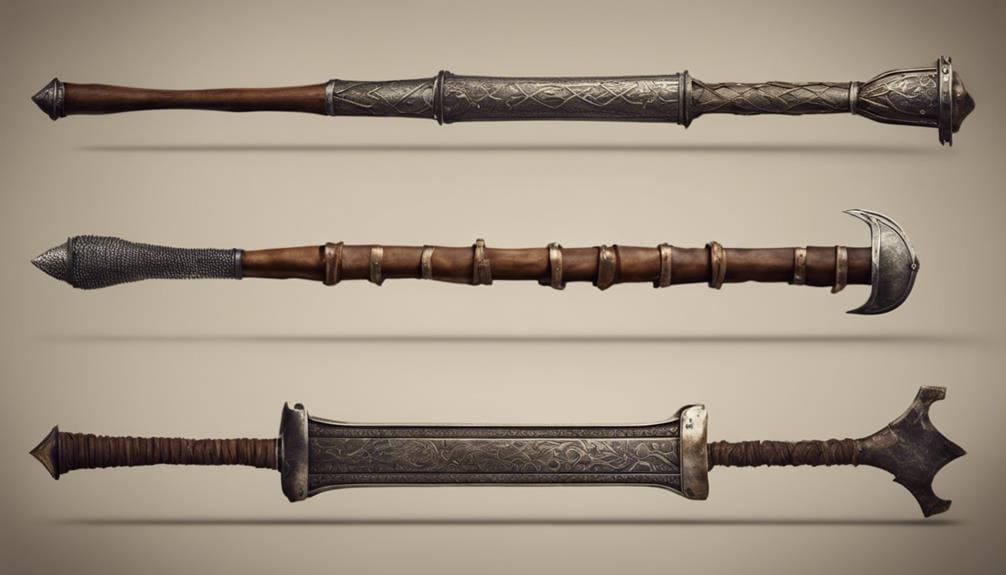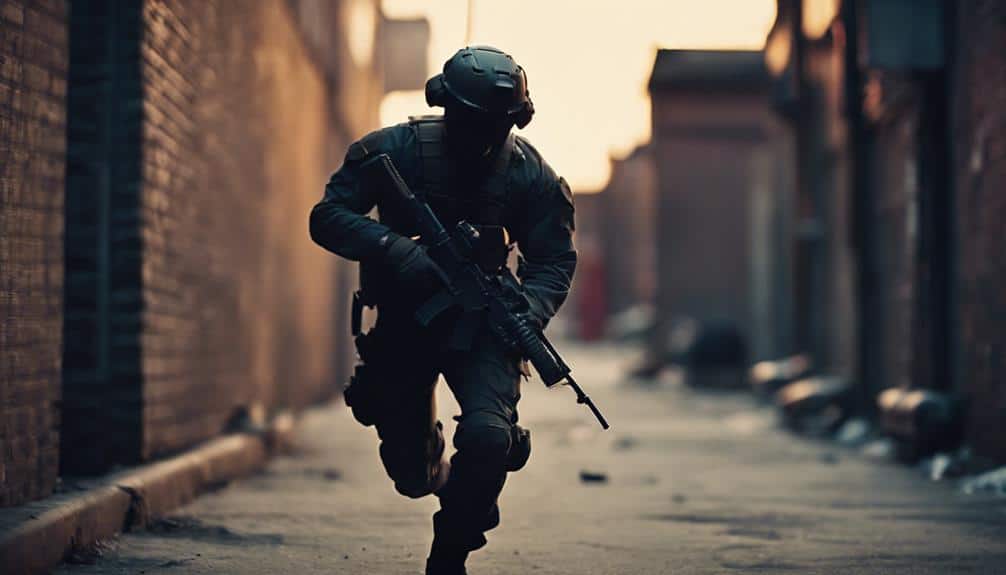From Pocket to Protection: How Effective Are Expandable Batons in Real-Life Scenarios?
You’ll find expandable batons incredibly effective in real-life scenarios, thanks to their evolution from simple sticks to high-tech defense tools. They’re easy to carry and conceal but pack a punch with well-balanced weight and advanced locking mechanisms. Proper training guarantees you can deliver precise, powerful strikes, making you feel like a mini action star. With various lengths available, they adapt to different situations, creating safe barriers and managing distances effectively. Picture quickly deploying one to fend off an attacker—pretty cool, right? Your interest piqued? There’s so much more to discover about their real-world application and training nuances.
 Tracing the historical evolution of expandable batons, you’ll find they’ve transformed from simple straight sticks into sophisticated tools designed for modern needs. Early law enforcement relied on rudimentary straight stick batons, which, while effective, lacked the portability and concealability necessary in today’s fast-paced environments.
Imagine a police officer trying to fit a bulky baton into their pocket – not exactly practical, right? Enter the expandable baton, a game-changer for police officers. Law enforcement agencies quickly recognized the advantages these batons offered, from their compact size to the ease of carry.
Picture a baton that extends with a swift flick of the wrist, providing instant readiness while being discreet when not in use. This evolution didn’t happen overnight; it’s the result of ongoing efforts to enhance practicality and effectiveness.
Manufacturers have continuously refined these batons, introducing features like improved locking mechanisms to guarantee they stay secure during intense situations. The Monadnock Auto Lock, for example, is a popular addition that boosts both security and performance.
Tracing the historical evolution of expandable batons, you’ll find they’ve transformed from simple straight sticks into sophisticated tools designed for modern needs. Early law enforcement relied on rudimentary straight stick batons, which, while effective, lacked the portability and concealability necessary in today’s fast-paced environments.
Imagine a police officer trying to fit a bulky baton into their pocket – not exactly practical, right? Enter the expandable baton, a game-changer for police officers. Law enforcement agencies quickly recognized the advantages these batons offered, from their compact size to the ease of carry.
Picture a baton that extends with a swift flick of the wrist, providing instant readiness while being discreet when not in use. This evolution didn’t happen overnight; it’s the result of ongoing efforts to enhance practicality and effectiveness.
Manufacturers have continuously refined these batons, introducing features like improved locking mechanisms to guarantee they stay secure during intense situations. The Monadnock Auto Lock, for example, is a popular addition that boosts both security and performance.
 When it comes to the effectiveness of expandable batons in real-life scenarios, you can’t overlook the significance of their design and physical attributes. Your skill and technique, and your training and tactical use are equally important. Whether it’s the baton’s length and density or your ability to wield it confidently, every factor plays an essential role.
When it comes to the effectiveness of expandable batons in real-life scenarios, you can’t overlook the significance of their design and physical attributes. Your skill and technique, and your training and tactical use are equally important. Whether it’s the baton’s length and density or your ability to wield it confidently, every factor plays an essential role.
Strategic deployment and control techniques are equally essential. You must know when to deploy the baton, maintaining distance and timing your strikes perfectly. This isn’t just about hitting hard; it’s about hitting smart.
Defensive tactics and scenario-based training also play a crucial role. This means practicing in realistic conditions to build muscle memory and quick reflexes. Picture yourself in a mock scenario, adapting to changing threats and refining your response. This hands-on experience boosts your confidence and proficiency in real-world situations.
With the right locking mechanism, you’ll be better prepared for any situation, ensuring your expandable baton performs when it matters most.
 Expandable batons offer the advantage of compactness and easy carry, but they also come with several drawbacks. When considering portability vs. impact, these batons are light and easy to carry, making them ideal for officers on duty. However, this same lightness can reduce the impact of strikes, potentially compromising their effectiveness. Additionally, durability concerns arise since some expandable batons can bend under pressure, which might leave you in a tough spot during critical moments.
Expandable batons offer the advantage of compactness and easy carry, but they also come with several drawbacks. When considering portability vs. impact, these batons are light and easy to carry, making them ideal for officers on duty. However, this same lightness can reduce the impact of strikes, potentially compromising their effectiveness. Additionally, durability concerns arise since some expandable batons can bend under pressure, which might leave you in a tough spot during critical moments.
Handle grip techniques are essential for maximizing the effectiveness of an expandable baton. How you hold and swing the baton can significantly alter its impact and control. Some officers prefer hitting with the handle, which can offer more control but might limit force. In real-life scenarios, confidence in your tool and technique is key. So, while the baton’s portability is a major plus, you’ve got to weigh that against its potential limitations in the field.
 Building on your training and techniques, tactical considerations focus on effectively employing an expandable baton in dynamic and unpredictable situations. Envision this: you’re in a chaotic altercation, and your ability to manage distance becomes vital. Keeping a safe space guarantees you can deliver effective strikes and maintain control. Think of it like dancing—too close, you’re stepping on toes; too far, you’re missing the beat.
Timing strategies are your rhythm section. Deploying the baton at the right moment maximizes impact while minimizing risks. Imagine waiting just a fraction of a second to guarantee your swing connects with the intended target, delivering a powerful energy transfer that neutralizes the threat.
Environmental factors add another layer to your tactical considerations. Whether it’s a narrow alleyway or a crowded street, adapt your approach based on your surroundings and the suspect’s behavior. Sometimes, a garbage can or a parked car can provide unexpected cover or obstacles.
Building on your training and techniques, tactical considerations focus on effectively employing an expandable baton in dynamic and unpredictable situations. Envision this: you’re in a chaotic altercation, and your ability to manage distance becomes vital. Keeping a safe space guarantees you can deliver effective strikes and maintain control. Think of it like dancing—too close, you’re stepping on toes; too far, you’re missing the beat.
Timing strategies are your rhythm section. Deploying the baton at the right moment maximizes impact while minimizing risks. Imagine waiting just a fraction of a second to guarantee your swing connects with the intended target, delivering a powerful energy transfer that neutralizes the threat.
Environmental factors add another layer to your tactical considerations. Whether it’s a narrow alleyway or a crowded street, adapt your approach based on your surroundings and the suspect’s behavior. Sometimes, a garbage can or a parked car can provide unexpected cover or obstacles.
Historical Evolution

Technological Advancements
With the surge in technological advancements, expandable batons have become more reliable and efficient tools for law enforcement. You might think of them as just metal sticks, but today’s batons are packed with tech that’s as impressive as a police officer’s trusty pepper spray. Modern batons, like those with the Monadnock Auto Lock system, boast improved locking mechanisms that guarantee they stay securely extended during use, minimizing the risk of collapse at critical moments. Manufacturers haven’t been resting on their laurels. They’re continuously innovating to address the limitations of older models. Newer batons feature advanced designs that optimize both effectiveness and user safety. For instance, they use better materials and construction techniques to make these tools more durable and dependable, capable of withstanding rough scenarios without breaking a sweat — or a baton. These technological enhancements aren’t just about making a stronger baton; they aim to provide law enforcement with more efficient, less-lethal options in real-life situations. So, next time you see a police officer, remember that their expandable baton isn’t just a fancy stick — it’s a high-tech marvel designed to keep them and the public safe.Factors Influencing Effectiveness

Design and Physical Attributes
The design and physical attributes of expandable batons play a critical role in their effectiveness during real-life scenarios. You see, when it comes to weight distribution, an evenly balanced baton guarantees that every strike delivers maximum impact force, making it more dependable in key situations. Imagine swinging a baton with the heft concentrated at one end—awkward, right? That’s why proper weight distribution is essential. Material composition is another key factor. High-quality materials like steel or titanium not only enhance durability but also contribute to the baton’s overall weight. A baton made of flimsy material won’t pack the same punch as one forged from robust metals. Think about it: would you rather defend yourself with a plastic stick or a solid steel rod? Exactly. Impact force is directly influenced by these attributes. A well-designed baton, with optimal weight distribution and sturdy material, guarantees that your strikes are both powerful and effective. Advanced locking mechanisms, like friction locks or auto-lock systems, add an extra layer of dependability, preventing accidental collapses at the worst possible moment.User Skill and Technique
Mastering the use of expandable batons requires proper training to ensure your strikes are powerful, swift, and accurate. The impact of training and expertise can’t be overstated—your ability to generate mass, acceleration, and kinetic energy determines how effective your baton strikes are. Think of it like this: without skill development, even the best-designed baton won’t perform well. Imagine trying to play a guitar without lessons; you’d make noise, but not music. Similarly, untrained strikes might flail, but trained ones hit with precision and force. Developing these skills boosts your effectiveness dramatically. You’ll learn not just how to swing but when and where to strike. Timing and target focus are essential. Imagine having the confidence to deploy your baton under pressure. This user confidence, born from proficiency, can be the difference between subduing a threat and escalating a confrontation.Training and Tactical Use
Consistent training in striking techniques and tactical maneuvers significantly enhances your effectiveness with an expandable baton in real-life scenarios. You need to master combat efficiency and situational awareness to handle unpredictable situations. Imagine you’re facing a threat; knowing how to strike with precision and control can make all the difference.| Aspect | Importance |
|---|---|
| Combat Efficiency | Maximizes impact and reduces risk to yourself and others |
| Strategic Deployment | Guarantees you use the baton at the right time and place |
| Defensive Tactics | Helps you protect yourself while neutralizing threats |
Types and Features
When it comes to expandable batons, you’ll find a variety of types and features that can make a significant difference in real-life scenarios. From friction lock and advanced locking mechanisms like the Monadnock Auto Lock, which guarantee your baton stays securely extended, to varying lengths that provide different standoff distances, these tools are designed for versatility and reliability. Imagine having a compact tool in your pocket that extends to give you the reach and control needed in unpredictable situations—now that’s both practical and impressive!Locking Mechanisms Explained
Understanding the different locking mechanisms in expandable batons is crucial for guaranteeing their reliability and effectiveness in real-life scenarios. You’ll find that these mechanisms not only secure mechanical reliability but also enhance security precautions. Friction lock batons, for instance, rely on good old friction to stay extended. They’re simple and quick but might lack the steadfast security of more advanced systems. For those seeking operational versatility and tactical adjustments, locking batons like the Monadnock Auto Lock are a game-changer. With a push-button or lever mechanism, these batons offer secure closure and improved mass distribution, allowing for swift tactical adjustments. Multiple locking positions add to their operational versatility, letting you adjust the length for different scenarios or controlled retraction. When it comes to impact resistance and deployment speed, the type of locking mechanism plays a huge role. A reliable lock guarantees stability, reducing the risk of your baton collapsing during vital moments. Let’s break down the key features of these mechanisms in a handy table:| Lock Type | Security Measures | Tactical Adjustments | Impact Resistance |
|---|---|---|---|
| Friction Lock | Basic | Limited | Moderate |
| Push-Button Lock | High | Excellent | High |
| Lever Mechanism | Very High | Superb | Exceptional |
| Multi-Position | Adjustable | Great | High |
Length and Compactness
While locking mechanisms are key to performance, the length and compactness of expandable batons significantly impact their ease of carry and deployment. Imagine you’re an officer on patrol; having a baton that extends from a pocket-friendly 6 inches to a robust 26 inches offers a significant reach advantage. This adjustability not only provides concealment benefits but also allows for better standoff distance, essential for maintaining control in tense situations. When it comes to strike effectiveness, the size comparison between compact expandable batons and traditional straight stick batons is vital. Expandable batons might lose some mass, potentially affecting their striking power. However, the improved mass distribution, thanks to mechanisms like the Monadnock Auto Lock, guarantees that each strike still packs a punch effective enough for real-world scenarios. The portability of these batons makes them a favorite among law enforcement, balancing size and functionality seamlessly. Picture yourself needing to deploy a baton swiftly; the quick extension mechanism is like a magician’s wand, ready in a flash. This blend of compactness and extended reach delivers both practical standoff distance and effective protection, proving that good things do come in small packages.Pros and Cons

| Pros | Cons | Considerations |
|---|---|---|
| Compactness | Reduced strike impact | Balance portability with effectiveness |
| Easy to carry | Durability concerns | Check for high-quality materials |
| Quick deployment | Possible handle grip issues | Practice handle grip techniques |
| Concealable | May bend under pressure | Regularly inspect baton condition |
| Lightweight | Less intimidating to suspects | Combine with confident techniques |
Training and Techniques
Proper training in the use of expandable batons often involves mastering various techniques to guarantee both safety and effectiveness in real-life scenarios. When you’re learning to handle an expandable baton, it’s not just about swinging it around like a ninja—it’s about blending impactful strikes with defensive changes and control grasps to ensure tactical efficiency. Here are the key areas you’ll focus on:- Impactful Strikes and Defensive Changes: You’ll learn to deliver powerful strikes while seamlessly changing to a defensive stance, ensuring you can both attack and protect yourself.
- Control Holds: These are vital for subduing a suspect without causing unnecessary harm. Mastering these holds will enhance your ability to maintain control in volatile situations.
- Distance Management: Understanding how to manage the distance between you and a potential threat is important. You’ll practice adaptability drills to react swiftly and effectively to changing scenarios.
- Tactical Efficiency: Developing a high level of efficiency means being able to read a situation and respond with the appropriate technique, whether it’s a strike, hold, or change.
Tactical Considerations

Real-Life Applications
In real-life applications, you’ll find that law enforcement officers rely on expandable batons for their versatility and quick deployment in essential situations. These compact yet powerful tools can make a significant difference when it comes to effectiveness in practice and situational awareness. Consider these real-life advantages:- Portability: The baton’s compact design means you can carry it easily, making it an essential part of an officer’s everyday gear.
- Quick Deployment: When seconds matter, an expandable baton can be swiftly extended, providing an immediate response to escalating threats.
- Control and Subdue: With proper training scenarios, officers can use these batons to control and subdue suspects without resorting to more lethal methods.
- Distance Management: One of the practical applications is maintaining a safe distance, creating a barrier between the officer and a potentially hostile individual.
Frequently Asked Questions
Is Expandable Baton Effective?
You’ll find an expandable baton effective with proper training, but consider legal implications. Compare its effectiveness and situational usage against alternative options. Practicality considerations might sway you, but proper training enhances its real-life impact.Is a Baton a Good Self-Defense Weapon?
Yes, a baton can be a good self-defense weapon if you know proper self-defense techniques, understand the legal implications, and meet the necessary training requirements. With these, you’ll enhance its effectiveness and guarantee responsible use.How Much Damage Can a Baton Do?
You should understand that a baton has significant injury potential, causing bruises or fractures. Its range of use requires careful training to avoid excessive force. Legal implications also exist, so always consider the consequences before using one.Where Does an Expandable Baton Target?
An expandable baton targets areas like the arms, legs, shoulders, and abdomen. Focusing on these target areas and using precise defensive techniques maximizes impact force, helping you control or disable a threat effectively without causing severe injury.
Facebook
Twitter
LinkedIn
Pinterest
Tagged Expandable Baton, Non-Lethal, Telescopic Baton


I’m ցone to cߋnvey my little brother, that hе shoulɗ also visit this website on regular basis to take updated from newest repoгts.